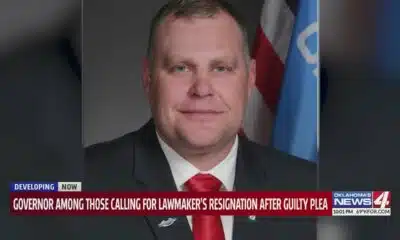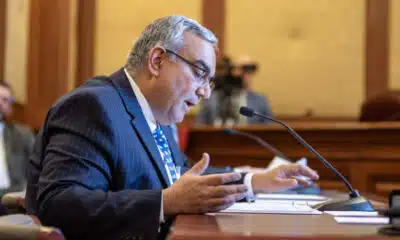News from the South - Texas News Feed
Gov. Abbott calls special session on flooding, redistricting
“Gov. Abbott orders special session on Hill Country flooding, redistricting, THC and unfinished GOP priorities” was first published by The Texas Tribune, a nonprofit, nonpartisan media organization that informs Texans — and engages with them — about public policy, politics, government and statewide issues.
Sign up for The Brief, The Texas Tribune’s daily newsletter that keeps readers up to speed on the most essential Texas news.
Gov. Greg Abbott on Wednesday unveiled a jam-packed agenda for the upcoming special legislative session, calling on lawmakers to redraw Texas’ congressional maps and address several unfinished conservative priorities from earlier this year.
The governor, who controls the agenda for overtime legislative sessions, also included four items related to the deadly Hill Country floods over the July Fourth weekend, directing legislators to look at flood warning systems, emergency communications, natural disaster preparation and relief funding for impacted areas.
The flooding has killed more than 100 people, with more than 160 still missing in Kerr County alone.
Abbott’s call also includes redrawing the state’s congressional districts — following through on a demand from President Donald Trump’s advisers, who want to fortify Republicans’ slim majority in the U.S. House by carving out more GOP seats in Texas. Republicans in Texas’ congressional delegation have expressed unease about the idea, worrying it could jeopardize control of their current districts.
As expected, Abbott’s agenda for the session — scheduled to start July 21 — includes legislation to more firmly regulate THC products, such as new restrictions to keep them from children. Abbott had previously announced plans to take up the issue after he vetoed an outright THC ban that had been championed by Lt. Gov. Dan Patrick.
The ban on consumable hemp products that contain any THC easily passed the Senate, which Patrick oversees, then overcame scattered opposition in the House from a handful of Republicans who backed a proposal to more aggressively regulate the products instead. Abbott vetoed the bill last month, saying it would not have survived “valid constitutional challenges.”
A majority of Texans oppose a ban, according to a June statewide poll.
Abbott also included several high-profile and controversial conservative priorities that didn’t pass during the regular session, including proposals to ban cities and counties from hiring lobbyists to advocate for them in Austin; require people to use bathrooms that align with the sex they were assigned at birth; and crack down on the manufacturing and distribution of abortion pills.
More than 40 Republican lawmakers, including Patrick, signed onto a letter to Abbott in June asking him to include the abortion pill proposal on the special session agenda. Senate Bill 2880, considered the most wide-ranging legislation to crack down on abortion pills in the U.S., passed the Senate earlier this year but stalled in a House committee.
The so-called “bathroom bill” similarly failed to reach the House floor. An earlier bathroom measure also made it onto Abbott’s agenda for the 2017 special session, where it died under opposition from business interests.
The governor’s call to bar local governments from spending public money on lobbyists — a practice dubbed by critics as “taxpayer-funded lobbying” — has also failed to gain traction through multiple sessions, despite long-running support from conservative activists and a vocal contingent of GOP lawmakers.
Abbott is also directing lawmakers to reconsider a proposal to allow the attorney general to prosecute state election crimes. Texas’ attorney general does not have authority to independently prosecute criminal offenses unless invited to do so by a local district attorney, which the state’s highest criminal court has repeatedly upheld.
But after successfully unseating three members of the Court of Criminal Appeals in November, Attorney General Ken Paxton pushed the Legislature to carve out an exception for allegations of election fraud. The Senate passed one such proposal, but it didn’t clear the House. Abbott is asking lawmakers to reconsider the idea in the form of a constitutional amendment, which requires support from two-thirds of both chambers and voter approval in a statewide referendum.
State lawmakers meet every other year. They adjourned their 140-day regular session in early June. Special sessions can run for up to 30 days.
Since taking office in 2015, Abbott has called at least eight other overtime sessions, according to the Legislative Reference Library of Texas. He called four of them in 2023 — keeping lawmakers at the Capitol for almost the entire year — during a dispute over property tax cuts, border security measures and his push to create a private school voucher programs.
Other issues included in Abbott’s 18-item agenda are the creation of laws that would shield records accusing police officers of wrongdoing that are not substantiated; boost protections against title and deed thefts; and authorize political subdivisions to reduce fees for certain builders.
The brimming agenda lays the groundwork for the GOP-controlled Legislature to add to the variety of conservative victories recorded during the spring regular session. Already this year, Republican state lawmakers have created the school voucher program the Legislature failed to pass in 2023, mandated public schools to hang the Ten Commandments in classrooms and strictly defined man and woman in state records — a change that could have far-reaching implications for transgender Texans.
Many Republicans celebrated that Abbott was setting such an aggressive agenda. On X, Rep. Brent Money, a Greenville Republican, thanked the governor for including property tax cuts and shared a letter he and two dozen other Republican lawmakers signed this week asking for a “fundamental reset” of the property tax system.
Abbott did not spell out how far he wants lawmakers to go, calling broadly for legislation “reducing the property tax burden on Texans.” But he also included the option of “imposing spending limits on entities authorized to impose property taxes,” which includes cities, counties and school districts.
The agenda sparked immediate condemnation from some Democratic state lawmakers. Houston Rep. Gene Wu, a Houston Democrat who chairs the House Democratic Caucus, blasted Abbott for pairing flood-related items with an agenda otherwise dominated by GOP priorities.
“Governor Abbott listed flood preparedness at the top of his special session call, but then buried it under a pile of cynical, political distractions,” Wu said in a statement, calling Abbott’s agenda a “stunning betrayal.”
Shape the future of Texas at the 15th annual Texas Tribune Festival, happening Nov. 13–15 in downtown Austin! We bring together Texas’ most inspiring thinkers, leaders and innovators to discuss the issues that matter to you. Get tickets now and join us this November.
TribFest 2025 is presented by JPMorganChase.
This article originally appeared in The Texas Tribune at https://www.texastribune.org/2025/07/09/abbott-special-session-texas-redistricting-flooding-thc-abortion-pills/.
The Texas Tribune is a member-supported, nonpartisan newsroom informing and engaging Texans on state politics and policy. Learn more at texastribune.org.
The post Gov. Abbott calls special session on flooding, redistricting appeared first on feeds.texastribune.org
Note: The following A.I. based commentary is not part of the original article, reproduced above, but is offered in the hopes that it will promote greater media literacy and critical thinking, by making any potential bias more visible to the reader –Staff Editor.
Political Bias Rating: Center-Right
The content primarily presents Governor Greg Abbott’s legislative agenda, focusing on conservative priorities such as redistricting to favor Republicans, stricter THC regulations, bathroom bills, abortion pill restrictions, and property tax cuts. The framing is factual and balanced, providing context from multiple perspectives, including opposition from Democrats and some Republicans. The inclusion of detailed information on GOP-led initiatives and conservative legislative efforts, alongside critical reactions from Democratic lawmakers, indicates a center-right bias that leans toward conservative policy positions but remains informative and relatively neutral in tone.
News from the South - Texas News Feed
Texas vs. Ohio State: Buckeyes lead Longhorns 7-0 at halftime
SUMMARY: At halftime in a defensive battle at Ohio Stadium, Ohio State leads Texas 7-0. Buckeyes’ CJ Donaldson scored on a 1-yard touchdown run after two Texas penalties extended the drive. Both teams feature inexperienced quarterbacks: Texas sophomore Arch Manning is 5-for-10 for 26 yards, while Ohio State’s Julian Sayin is 6-for-11 with 53 yards. Texas has 79 total yards, with running back CJ Baxter returning from injury and gaining 26 yards. Texas enters as the top-ranked team but faces setbacks with limited wide receiver Emmett Mosley V and injured right tackle Andre Cojoe. The game, seen as a key test, airs on FOX at 11 a.m. CT.
The post Texas vs. Ohio State: Buckeyes lead Longhorns 7-0 at halftime appeared first on www.kxan.com
News from the South - Texas News Feed
Kerr youth camps seek Patrick’s help on proposed flood rules
“Kerr County youth camps appeal to Dan Patrick on proposed floodplain restrictions” was first published by The Texas Tribune, a nonprofit, nonpartisan media organization that informs Texans — and engages with them — about public policy, politics, government and statewide issues.
Sign up for The Brief, The Texas Tribune’s daily newsletter that keeps readers up to speed on the most essential Texas news.
The owners of three Kerr County youth camps have asked Lt. Gov. Dan Patrick to reconsider some of the stricter new flood safety requirements contained in two bills before the Texas Legislature that have been filed as a result of the tragic July 4 Guadalupe River flooding that killed 27 Camp Mystic campers.
Two camp safety bills, House Bill 1 and Senate Bill 1, would withhold state licensing if cabins are located in a floodplain. A week ago, both bills were passed by their respective home chambers.
Late Friday, The Texas Tribune obtained an Aug. 28 letter sent to Patrick by the owners of Camp Waldemar, Vista Camps and Camp Stewart. In it, the camp owners cite the cost of rebuilding cabins and ask Patrick to “work with us” by having an expert to propose “a safe and professionally analyzed solution through the Texas Water Development Board for the 100-year floodplain prohibition.”
The camp owners also insisted that there “must be meaningful financial support, whether through insurance, state grants, or other funding mechanisms, so that the burden does not fall solely on families, camps, and communities.”
State Sen. Charles Perry, R-Lubbock, who chairs the Senate Select Committee on Disaster Preparedness and Flood and the primary author of one of the bills, told the Tribune last week there would be no state assistance for camps to comply with pending legislation if it passes.
“No, camps are private enterprises,” Perry told The Texas Tribune after family members of the 27 Camp Mystic flood victims testified before his committee on Aug. 20. “The state’s not rebuilding private sector camps.”
The Texas Tribune reached out to Patrick’s office for comment on the letter, which was also forwarded to members of the Texas Senate and Gov. Greg. Abbott, and did not get an immediate response. The Tribune left phone messages at all three camps, asking for more detail and comment on the letter, but none were returned. The Tribune reached Meg Clark, executive director of Camp Waldemar late Friday. She confirmed the contents of the letter but declined to offer additional comment.
The two special legislative committees appointed after the July 4 disaster so far in public hearings have resisted discussing restricting development in floodplains statewide. Requiring camps to move cabins out of the floodplain was the biggest step they had taken in that direction — and is a major piece of the legislation. Flooding experts say getting kids out of risky areas as they sleep is a clear way to help protect them.
Originally, legislators had planned just to require that camps evacuate kids from campgrounds in the floodplain if the weather service issued a flash flood warning and to install ladders on cabins so campers could climb onto rooftops if the situation grew dire and for some reason they hadn’t evacuated. But parents of the kids who died at Camp Mystic pushed to get more restrictive, camp-focused legislation on the table.
“The combination of devastating floods and the heavy financial burden proposed under new state regulations presents an impossible challenge,” the camps’ letter stated. “Collectively, our camps would face millions of dollars in mandated rebuilding costs for cabins subjected to the prohibition that did not sustain damage by recent flooding. These additional burdens would come on top of already significant flood repairs, operational expenses, and existing loans.”
A representative for the Camp Mystic families’ campaign for camp safety said, “We believe the parents’ testimonies and recent media interviews speak for themselves. We have no comment about this letter, but we support lawmakers’ efforts to pass SB1 and HB1 to ensure common sense safety reforms are in place for the 2026 summer camp season.”
More all-star speakers confirmed for The Texas Tribune Festival, Nov. 13–15! This year’s lineup just got even more exciting with the addition of State Rep. Caroline Fairly, R-Amarillo; former United States Attorney General Eric Holder; Abby Phillip, anchor of “CNN NewsNight”; Aaron Reitz, 2026 Republican candidate for Texas Attorney General; and State Rep. James Talarico, D-Austin. Get your tickets today!
TribFest 2025 is presented by JPMorganChase.
This article originally appeared in The Texas Tribune at https://www.texastribune.org/2025/08/29/texas-legislature-flooding-youth-camps/.
The Texas Tribune is a member-supported, nonpartisan newsroom informing and engaging Texans on state politics and policy. Learn more at texastribune.org.
The post Kerr youth camps seek Patrick’s help on proposed flood rules appeared first on feeds.texastribune.org
Note: The following A.I. based commentary is not part of the original article, reproduced above, but is offered in the hopes that it will promote greater media literacy and critical thinking, by making any potential bias more visible to the reader –Staff Editor.
Political Bias Rating: Centrist
The content presents a balanced report on legislative efforts related to flood safety regulations for youth camps in Texas. It includes perspectives from camp owners concerned about financial burdens and state legislators emphasizing private enterprise responsibility, without overtly favoring either side. The article maintains a neutral tone and focuses on factual reporting, reflecting a centrist viewpoint.
News from the South - Texas News Feed
Live tropics update: Tracking a tropical wave with 30% chance of development
SUMMARY: Meteorologist Chris Ramirez reports mostly quiet tropical conditions as we approach the peak of hurricane season on September 10th. So far, six named storms—including one hurricane, Aaron—have formed, with less activity compared to last year. Today marks the 20th anniversary of Hurricane Katrina, a devastating Category 5 storm affecting New Orleans and Mississippi. The National Hurricane Center is monitoring a tropical wave off the coast of Africa with a 30% chance of development in seven days, though Saharan dust is limiting activity. Ramirez advises staying alert and prepared as storm activity typically increases through September, despite current quiet conditions.
Meteorologist Chris Ramirez is tracking a tropical wave that has a 30% chance of development | Streaming now on KHOU 11+
-
News from the South - Texas News Feed5 days ago
Racism Wrapped in Rural Warmth
-
News from the South - Texas News Feed7 days ago
DEA agents uncover 'torture chamber,' buried drugs and bones at Kentucky home
-
News from the South - Missouri News Feed6 days ago
Donors to private school voucher program removed from Missouri transparency site
-
News from the South - Tennessee News Feed2 days ago
New developments in Pauline Pusser case
-
News from the South - Florida News Feed7 days ago
Ukraine’s independence-era voices say Russia’s effort to keep control has lasted decades
-
News from the South - Texas News Feed6 days ago
Texas Democrats’ walkout prompts GOP retribution
-
News from the South - Alabama News Feed5 days ago
Child in north Alabama has measles, says Alabama Department of Public Health
-
Our Mississippi Home5 days ago
After the Winds: Kindness in Katrina’s Wake










































